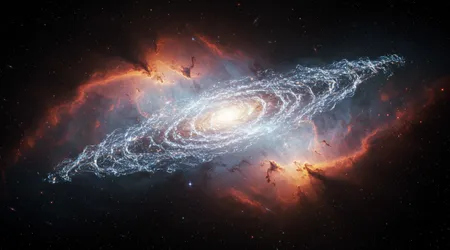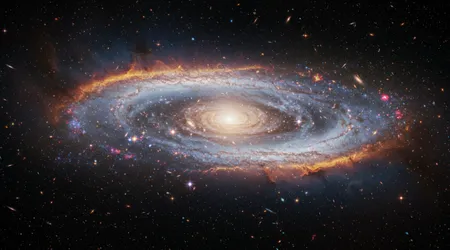Could There Be Structures in the Universe Bigger Than the Observable Universe?

Could There Be Structures in the Universe Bigger Than the Observable Universe? This question stirs the imagination, blending cosmic wonder with scientific rigor.
Anúncios
The observable universe, a sphere roughly 93 billion light-years wide, contains galaxies, superclusters, and vast cosmic webs. Yet, could structures exist beyond this boundary, dwarfing our observable cosmos?
This article dives into the enigma, exploring recent discoveries, theoretical possibilities, and the limits of our cosmic vision.
From the Big Ring to cosmic inflation, we’ll unravel whether the universe harbors giants too vast to see, grounded in real data and fresh perspectives. Let’s embark on this journey to probe the unseen.
The observable universe is a snapshot, limited by light’s finite speed and the universe’s 13.8-billion-year age. Light from distant objects hasn’t reached us yet. Beyond this horizon, the universe might extend infinitely or curve back on itself.
Structures like galaxy filaments, stretching billions of light-years, hint at larger unseen formations. The cosmological principle assumes uniformity, but recent findings challenge this.
Could megastructures exist, hidden by distance or cosmic mechanics? These questions drive modern cosmology, pushing us to rethink our place in the vast unknown.
Our curiosity about the cosmos isn’t new, but 2025 brings fresh data and debates. Discoveries like the Big Ring, a 1.3-billion-light-year structure, spark intrigue.
This article will explore these findings, blending hard science with speculative wonder. We’ll examine how cosmic inflation, dark energy, and new telescope data shape our understanding.
Are there structures so immense they defy our models? Let’s dive deeper, with real evidence and original insights guiding the way.
The Observable Universe: A Finite Window
The observable universe is our cosmic lens, defined by light’s travel time. It spans 93 billion light-years, encompassing countless galaxies and stars. Yet, this is merely what we can see.
Light’s finite speed limits our view, leaving vast regions unexplored. Could There Be Structures in the Universe Bigger Than the Observable Universe? The question hinges on what lies beyond this light-bound horizon.
Cosmologists estimate 2 trillion galaxies exist within our observable patch. These form filaments, walls, and voids in a cosmic web. The largest known structures, like the Hercules-Corona Borealis Great Wall, span 10 billion light-years. Such scales already strain theoretical limits.
If the universe is infinite, even larger structures could exist, unseen. The challenge is detecting them without light’s evidence.
Recent observations, like those from the James Webb Space Telescope, reveal early galaxies forming massive structures. These findings suggest the universe’s architecture is complex.
Beyond our view, structures might dwarf these giants. The cosmological principle, assuming uniformity, may not hold if megastructures exist. This possibility excites scientists, urging new ways to probe the unseen.
++ What’s Causing the Great Void in Our Cosmic Neighborhood?
The observable universe’s boundary isn’t a physical wall but a temporal limit. Light from beyond hasn’t had time to reach us. If structures exist past this, they could redefine cosmology.
Theories like cosmic inflation suggest rapid early expansion, potentially creating vast, unseen formations. Exploring these ideas requires innovative tools and bold hypotheses.

The Big Ring and Giant Arc: Cosmic Anomalies
In 2021, Alexia Lopez, a PhD student, discovered the Giant Arc, a 3.3-billion-light-year structure. In 2024, she unveiled the Big Ring, 1.3 billion light-years wide.
Could There Be Structures in the Universe Bigger Than the Observable Universe? These findings, presented at the American Astronomical Society, challenge the cosmological principle. Structures this large shouldn’t exist under current models.
The Big Ring, near Boötes, appears as a vast galaxy arrangement. Its size, equivalent to 15 full moons in the sky, defies expectations.
The Giant Arc, also in Boötes, suggests a connected system. These structures breach the theoretical 1.2-billion-light-year limit for cosmic formations. Their existence hints at even larger, unseen megastructures.
Dr. Jenny Wagner noted these aren’t chance alignments. Baryonic acoustic oscillations or cosmic strings might explain them. Such mechanisms could form massive shells or faultlines.
Also read: The Axis of Evil in Space: Coincidence or Clue?
If confirmed, these anomalies suggest the universe’s structure is less uniform than thought. Could even grander formations lurk beyond our sight?
These discoveries rely on advanced telescopes and data analysis. The Dark Energy Spectroscopic Instrument (DESI) maps galaxies across 11 billion years.
Its 2025 data hints at dark energy’s variability, potentially linked to megastructures. These findings push cosmologists to rethink standard models, opening doors to bold theories.
The Big Ring and Giant Arc are just the beginning. Their proximity suggests a larger cosmic pattern. If structures this vast exist within our observable universe, what lies beyond? The question fuels ongoing research, with telescopes like Euclid seeking answers in 2025’s skies.
Cosmic Inflation and the Infinite Universe
Cosmic inflation, a rapid expansion post-Big Bang, reshaped the early universe. Occurring within 10^-32 seconds, it stretched space exponentially.
Could There Be Structures in the Universe Bigger Than the Observable Universe? Inflation suggests the total universe far exceeds our observable portion, possibly infinitely.
Inflation smoothed out initial irregularities, creating a uniform cosmos. Yet, it could also seed massive structures.
Quantum fluctuations during inflation might have formed galaxy clusters or larger. If the universe is infinite, these could grow without bound, hidden from our telescopes.
The Planck epoch, before inflation, saw all forces unified. Gravity’s role then could have sculpted immense structures. Current models, like Lambda-CDM, assume a flat, infinite universe. If true, megastructures beyond our view are plausible, shaped by inflation’s chaotic burst.
Read more: Why Time Might Not Be What We Think It Is
Observations of the cosmic microwave background (CMB) support inflation. The Planck satellite’s 2018 data showed a flat universe, implying infinite extent.
This aligns with megastructure possibilities. However, detecting them remains elusive, as light from such distances hasn’t arrived.
Inflation’s legacy might include structures spanning unimaginable scales. Analogous to ripples in a vast ocean, these could dwarf our observable universe.
Without direct evidence, we rely on theoretical models and indirect clues, pushing cosmology’s boundaries in 2025.
Dark Energy and Cosmic Expansion
Dark energy drives the universe’s accelerating expansion, comprising 68.3% of its contents. Could There Be Structures in the Universe Bigger Than the Observable Universe?
Its influence might allow structures to form on scales we can’t observe, stretching cosmic boundaries.
The Dark Energy Spectroscopic Instrument’s 2025 data suggests dark energy may weaken over time. This could imply varying expansion rates, affecting structure formation. If dark energy fluctuates, massive structures might stabilize beyond our observable horizon.
Dark energy’s homogeneity contrasts with matter’s clumping. Galaxies form clusters, but dark energy could support larger, unseen formations.
Cosmic strings or domain walls, theoretical defects, might span billions of light-years, driven by dark energy’s push.
A 2025 study from DESI, analyzing 15 million galaxies, hints at dark energy’s role in megastructures. If its strength varies, structures could grow larger than expected. This challenges the Lambda-CDM model, suggesting a dynamic cosmos with hidden giants.
What forces shape these potential megastructures? Dark energy’s mystery fuels speculation. Its interaction with gravity might create stable, colossal formations. As telescopes probe deeper, 2025’s data may reveal clues to these cosmic enigmas.
Tools and Techniques to Probe the Unseen
Detecting structures beyond the observable universe is daunting. Light’s finite speed limits our view, but 2025’s technology offers hope.
Could There Be Structures in the Universe Bigger Than the Observable Universe? Advanced tools like Euclid and DESI push the boundaries.
The Euclid telescope, launched in 2023, maps the universe’s geometry. Its 2025 data refines our understanding of cosmic curvature.
A flat universe suggests infinite extent, supporting megastructure theories. Euclid’s precision helps model unseen regions.
DESI’s galaxy mapping spans 11 billion years, revealing structure evolution. Its 2025 findings challenge dark energy’s constancy, hinting at larger formations. Gravitational lensing, detected by DESI, could reveal massive structures warping light from afar.
Cosmic microwave background studies, like those from Planck, probe early conditions. They suggest a flat, possibly infinite universe. Combining these with gravitational wave detectors could uncover unseen megastructures’ subtle effects.
Imagine searching for a city in fog, using only echoes. That’s cosmology’s challenge. Future missions, like the 2026 Simons Observatory, may detect megastructure signatures, revolutionizing our cosmic map in real time.
The Cosmic Web: A Framework for Giants

The cosmic web filaments, walls, and voids organizes the universe’s matter. Galaxy clusters form along these threads, spanning billions of light-years.
Could this web support structures larger than our observable universe? Its intricate pattern suggests vast possibilities.
Filaments like the Hercules-Corona Borealis Great Wall stretch 10 billion light-years. These are the largest known structures, but the web might extend further. If the universe is infinite, the web could host even grander formations, unseen by us.
The web’s structure arises from early quantum fluctuations, amplified by inflation. These could seed megastructures beyond our light horizon. The web’s connectivity hints at a cosmos where massive, hidden systems thrive.
Simulations, like those from the Illustris project, model the web’s evolution. They suggest filaments could link into superstructures spanning vast scales. In 2025, new simulations refine these models, hinting at unseen giants.
Picture the cosmic web as a spider’s silk, stretching endlessly. Its threads might weave structures too vast for our telescopes. Ongoing research in 2025 seeks to map this web’s furthest reaches.
Table: Largest Known Cosmic Structures (2025 Data)
| Structure | Size (Billion Light-Years) | Discovery Year | Key Features |
|---|---|---|---|
| Hercules-Corona Borealis | 10 | 2013 | Largest known galaxy wall |
| Giant Arc | 3.3 | 2021 | Challenges cosmological principle |
| Big Ring | 1.3 | 2024 | Near Giant Arc, possible connected system |
| Laniakea Supercluster | 0.52 | 2014 | Our galaxy’s home supercluster |
Source: University of Central Lancashire, 2024
Conclusion: Embracing the Cosmic Unknown
The question Could There Be Structures in the Universe Bigger Than the Observable Universe? ignites both wonder and debate.
Discoveries like the Big Ring and Giant Arc, spanning billions of light-years, challenge our models. Cosmic inflation and dark energy suggest an infinite universe, where megastructures could thrive beyond our sight.
With tools like Euclid and DESI, 2025’s cosmology pushes the boundaries, seeking clues in gravitational lensing and the cosmic web. These findings reshape our understanding, hinting at a cosmos far grander than we imagine.
Yet, the unknown persists. Are there structures so vast they dwarf our observable universe? The answer lies in future data, from telescopes to simulations.
For now, we stand at the edge of the cosmic horizon, peering into the abyss. The universe’s secrets beckon, urging us to explore, question, and dream.
As we chase these mysteries, we redefine our place in an ever-expanding cosmos, fueled by curiosity and real-time discoveries.
This journey isn’t just scientific it’s human. Consider the Big Ring, a structure so vast it defies our models, yet it’s just a glimpse.
Or picture a cosmic web stretching infinitely, like a tapestry woven by unseen hands. In 2025, with DESI’s data showing dark energy’s variability, we’re closer to answers.
What lies beyond our cosmic horizon? Let’s keep searching, driven by the thrill of the unknown.
Frequently Asked Questions
Q: How do we know structures like the Big Ring exist?
A: Astronomers use telescopes like DESI to map galaxies, revealing patterns like the Big Ring’s 1.3-billion-light-year span, confirmed in 2024.
Q: Can we ever see beyond the observable universe?
A: Light’s finite speed limits our view, but gravitational lensing and cosmic background radiation offer indirect clues to unseen structures.
Q: Why do large structures challenge the cosmological principle?
A: The principle assumes uniformity, but structures like the Giant Arc suggest the universe may have uneven, massive formations.
Q: What role does dark energy play in megastructures?
A: Dark energy’s expansion might stabilize vast structures, with 2025 DESI data suggesting its variability could influence their formation.
Q: Are there upcoming missions to study these structures?
A: Yes, the Euclid telescope and 2026 Simons Observatory will probe cosmic geometry and gravitational effects for megastructure clues.
